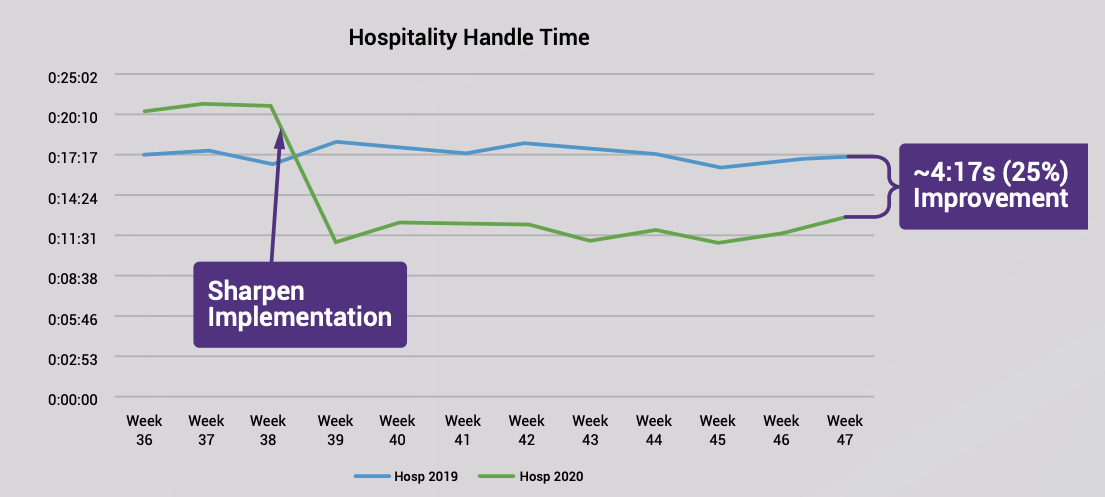
How to Calculate and Boost Your Call Center Operation’s ROI
Picture this: Better training. More agents. Streamlined technology. A vacation. You name it, you get it.
Sounds amazing, right?
Before we get too far down our wishlist, let’s take a step back and focus on what it takes to get us there. Running a successful call center means you’re in charge of keeping customers happy so your company can grow. And part of that growth plan is delivering an ROI on your call center to raise your company’s bottom line.
>> Download Now: Create a performance management plan for higher ROI on your call center (without the enterprise costs)
You and your execs know that customer service is important. And that without loyal customers, your business can’t grow. But just how much does your contact center actually contribute to your company’s bottom line?
When you can put a number to the value you bring to a company (and your execs know that number too), you can earn crucial budget to grow your operations and realize even more revenue. In fact, research shows for every cent a company spends to improve customer service, the ROI is between 34% to 400%.
Let’s walk through how to calculate the ROI of your business unit. Then, you can use what you find to further improve call center operations and meet lucrative business goals.
Use this equation to calculate your ROI:
Your Call Center ROI Percentage = [(Total Revenue – Total Expenses)/ Total Call Center Investment] x 100

First up, add up your investments
Think through the costs associated with your agents’ time, the resources they access and the technology they use. Plot out all the annual fixed costs for your contact center – like the rent for your building, stipends for current remote agents, your contact center software (if you have a contract in place), hourly wages and supervisor salaries.
Then, think through all your variable costs, too. Does having an interaction solved entirely by your IVR cut costs during some months, and tack on higher expenses in others? What ebbs and flows in your monthly operations, and what expenses can you predict on the nose each month?
>> Read Next: Amplify your call center operation’s ROI with performance management
Look to these cost categories to guide you:
Technology:
How much do you spend on contact center technology per agent? Do you have licenses for each agent for your contact center platform, your ticketing system, and your CRM? And, do you hire more agents to keep up with business seasonality? Use WFM tools and forecast predictions paired with vendor pricing to get a grip on how much technology costs your contact center each month.
Rent & Business Operations:
What’s the cost of running a brick and mortar operation? How much is rent for your call center space? What about electricity, internet and security? While these costs don’t matter as much to your budget, they matter to your COO. They’ll be factored into any larger company cost analysis, and your customer cost per contact, when execs set department budgets.
FTE Costs:
What’s the average salary for your agents and supervisors? How much time does IT spend supporting your contact center? Account for these wages, too. And, how much does it cost your agents to handle each interaction? If your Average Handle Time for a phone call sits at 6 minutes, you’re spending 10% of your agents’ hourly rate on a single interaction with a customer.
At Sharpen, we’ve helped customers calculate their AHT and associated costs so they can make a plan of attack to address inefficient processes. A hospitality services customer decided to focus on AHT to improve their call center operations and trim costs. They showed agents their handle times and how they were performing against contact center goals. After every interaction. That transparency made agents more productive. They shrunk AHT by 25%, reducing needed agent hours and projecting a savings of $323K.

New Hire Sourcing & Training:
With average attrition rates sitting at ~45%, you’re likely sourcing and hiring new candidates every month just to backfill positions, let alone grow your team. How much does it cost every time you lose an agent? What do you shell out to recruit, train and ramp a new agent? And, how much productivity do you lose while the seat sits empty?
Once you have numbers for your fixed and variable costs, find an average of your monthly variable costs, and add it to your fixed costs.
Let’s walk through an example of your variable costs:
Since your agents leave at varying rates, costs associated with agent attrition are variable costs. Let’s say in May, no agents left your call center. With a 100% retention rate, you didn’t incur any added costs. But in February, a few agents felt discouraged. They’d been working for your company for six months, yet rarely had conversations about their performance. So, three decided to jump ship. And, it cost you $15,000 (each!) to replace them. That means in February, you totaled $45,000 in variable costs, bringing your monthly average thus far to $22,500.
Now, calculate your contributions to company revenue
Did you know, it costs 16x more to nurture a new customer to the same level of revenue contribution of your existing, loyal customers? You operate a revenue-generating arm of business. Use your metrics and a call center ops analysis to uncover your gains.
Use these metrics to see how much you’re contributing to your bottom line:
Customer Lifetime Value:
What’s the average tenure of each of your customers? And, while they do business with you, how much predictable revenue do they contribute each year?
Customer Retention Rate:
On average, how many customers do you lose each year? And, when they leave, how much predictable revenue leaves with them?
Add-On Revenue:
What net new revenue comes from your existing customers each year?
Use these three metrics to clarify how your existing customers contribute to your Annual Recurring Revenue (ARR) each year compared to the fresh crop of customers sales brings in.
Then, look to other metrics and categories that have soft ROI. They help you shave operational costs (hiking final profits), but they don’t have a direct correlation to new or predictable revenue. Still, they often point to impacts to your bottom line – like retention, lower FTE costs and increased CLV.
Your agents’ productivity, agent turnover, IVR Containment Rate, Average Handle Time, and Active Contact Resolution are all associated with the costs of a call center (and the potential gains).
We know that companies in the U.S. lose out on a collective $450+ billion because of poor productivity. So, how does your agents’ productivity impact your revenue and profits? And, what’s your agent turnover rate? How much did you save your company in new hire costs by reducing that rate? Using average turnover costs and your agents’ salary info, we know in a 100-seat contact center, reducing turnover by 5% can save $176k to $600k.
Add up everything that’s in the green, and you get your total to plug into the ROI equation.
>> Learn More: How Managing and Coaching to Agent Performance Metrics Amplifies Your Call Center’s ROI
Use what you find to improve call center operations and ROI.
Is sky-high agent turnover stealing all your cash? Or, are angry customers pilfering your add-on revenue? Look to your metrics and cost analysis to guide you toward improvement.
If solving interactions in your IVR saves you tons of money each month, then how can you optimize your messaging to be even more helpful to your customers? Where can you proactively answer customer questions and cut down on the time spent talking to agents – lowering cost per contact and FTE costs?
Use these two methods to analyze and improve your call center operations and ROI.
1. Clarify agent expectations to improve performance (and cut costs).
A study from The Strategic Journal of Business & Change Management found that clear KPIs lead to better performance at work. Teams who work toward a clear, shared set of service KPIs prove to be more productive and engaged at work. And that productivity leads to fewer losses for your bosses. (Ahh, a good rhyme gets me every time.)
Setting goals and expectations for your team, then showing agents their progress, keeps them from running for the door. And, looping your agents in on how they’re performing against key metrics improves productivity and encourages faster (more accurate resolutions).
2. Look to your cost-saving metrics to further strengthen ROI.
Since you can tie metrics like FCR and AHT back to business costs, start with incremental improvements to these metrics. Can you bump AHT down by 1%? What about FCR (or ACR – FCR’s better-looking sister)?
When you coach agents to focus on these cost-saving metrics, you cut operational costs to boost net profits from your revenue. In fact, a friend of ours recently told us that after moving agents home and giving agents the right suite of tools (and the support they need) they dropped AHT by 4% in about two weeks. That 4% drop is projected to add thousands in efficiency savings back to their bottom line this year.
We originally wrote this post on May 27, 2020, and we updated it on September 12, 2022.

